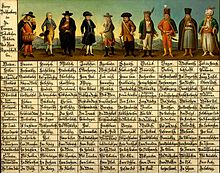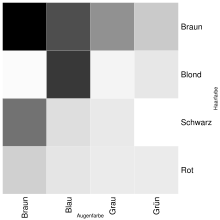Table (information)
A table (from Latin tabella literally for "[the] tablet" and also translated as "[the] blackboard") is an ordered compilation of texts or data. The contents to be displayed are divided into rows (horizontal) and columns (vertical), which are graphically aligned with each other. The first column of a table is called the first column if it describes or explains the contents of the fields of the other columns in the same row. The first lines of a table which contain explanations of the table contents and/or designate or explain the fields in the following lines of the individual columns form the table header; if this consists of only one line, this is called the header line. Furthermore, tables consist of table fields (cells). The reference to a field is the addressing (reference).
There is usually a semantic relationship between the contents of a cell and the row or column in which it is located.
- In relational databases, the term table stands for a collection of similarly structured data that is usually stored together in technical terms (see under database table).
- A spreadsheet is a computer program that is primarily suited for displaying and calculating even hypothetical numerical data on a large scale.
- In propositional logic, truth tables exist that clearly represent various operations and their possible outcomes.
Well-known tables are, for example, the Düsseldorf table and the periodic table.
· _EN.svg.png)
Periodic table
·
Table of endangered species
· ![]()
Data table
· 
Timetable
· 
Saturnoppositions
· 
HTML table

The Styrian Ethnological Table (c. 1725) is a tabular list of European peoples.
Data Tables
![]()
This article or section is in need of revision: Wikipedia is not a collection of how-to and how-to guides. No knowledge is presented here, but instructions and poorly referenced opinions on design, the generality of which cannot be understood.
Please help improve it, and then remove this tag.
Construction
| Table 1: Absolute frequencies of eye and hair color combination of 592 statistics students. Source: Package datasets in R. | |||||
| Eye color | |||||
| Hair color | Brown | Blue | Grey | Green | Total |
| Brown | 119 | 84 | 54 | 29 | 286 |
| Blonde | 7 | 94 | 10 | 16 | 127 |
| Black | 68 | 20 | 15 | 5 | 108 |
| Red | 26 | 17 | 14 | 14 | 71 |
| Total | 220 | 215 | 93 | 64 | 592 |
| Table 2: Conditional frequencies of eye colors given a hair color. | |||||
| Eye color | |||||
| Hair color | Brown | Blue | Grey | Green | Total |
| Brown | 42 % | 29 % | 19 % | 10 % | 100 % |
| Blonde | 5 % | 74 % | 8 % | 13 % | 100 % |
| Black | 63 % | 18 % | 14 % | 5 % | 100 % |
| Red | 36 % | 24 % | 20 % | 20 % | 100 % |
| Total | 37 % | 36 % | 16 % | 11 % | 100 % |
The aim of tables is to provide an overview of detailed information in a short and concise form. In order to be able to extract the relevant information from tables, an appropriate structure or design is necessary. Therefore, some rules for better readability should be observed:
- Tables should contain explanatory text in an over- or caption.
This is because readers may only read the table, and then the most important information should be included in the
heading or caption. Also, in an automatic (dynamic) layout, a table is moved to the next page after the descriptive text for space reasons, and even then, additional information is important. - Table headings or the legend should contain a separate identifier, for example a numbering, for documents with several tables.
- Then you can clearly refer to a specific table in the accompanying text.
- A table should also be described in the accompanying text.
A table is often not easy to read, so the important statements in the table should be pointed out in the accompanying text. Otherwise, readers who are not familiar with the subject matter might not grasp the meaning of the table. - A table should not contain too many columns and rows.
The psychologist George A. Miller proved in 1956 that one can
only remember"information" in
short-term memory. Therefore, a guide to the number of columns and rows is
each.
- Rows and columns should be in natural order or ordered by size.
In Table 1, the rows and columns are ordered by row or column totals. Alternatively, alphabetical sorting by hair or eye color name would have been possible here. The order in Table 2 follows Table 1, since the reader is already familiar with the order in Table 1. - You should not use repeat characters, such as "ditto".
It is better to leave the place empty or simply repeat the number. - Tables should not contain unrelated information.
It is then better to split the information into two or more tables. For example, Table 1 and Table 2 could have been combined into one table, but the information is better presented in two tables. - The layout should "guide" the eye:
- Avoid vertical lines
- Avoid double lines
- To support the readability it is better to use background colors instead of a line "network".
- A good example can be found in the documentation for the LaTeX package booktabs on page 2.
- Units of measurement should be written in the header of each column.
If you omit the units of measurement, it is unclear in which unit of measurement the data is given. If you write them at the bottom of the table, you have to search for them first. - Totals (or averages) should be given for columns and rows if possible/necessary.
This saves a reader from having to calculate the totals and also allows them to check the table values. - Values that are to be compared had better be in different columns and not in different rows.
From each column in Table 2, a statistician can immediately infer that there is a relationship between hair and eye color because of the different values. - Text should be set flush left.
Readers whose native language is German are used to text being written from left to right and can therefore grasp left-justified text more quickly. In languages where the writing direction is different, e.g. Hebrew or Arabic, right-justified texts will be preferred. - For numbers:
- Large numbers should be placed at the top if possible
- They should be set right-justified
- They should be rounded to two or three significant digits
- They should contain leading zeros, i.e. "0,1" instead of ",1".
- The decimal points for numbers in a column should always be placed below each other.
- Table 2 gives an example of this. However, rounding the entries to whole percentages using commercial rounding leads to the problem that the row total no longer adds up to 100%, but to 99% or 101%. Therefore, sum-preserving rounding has been used here.
The rules are intended to help improve the understanding and readability of tables and do not apply absolutely. Table 1 shows the eye and hair color data set with the absolute frequencies of statistics students with the aim of showing a dependency between eye and hair color. The rules have been followed as much as possible, e.g. the background color changes from row to row to make it easier to read the values in a row, or the eye and hair colors have been sorted by the size of the column or row totals. However, since the table standard in Wikipedia is to use a grid of lines, this has been retained, unlike the rules. From Table 2, one can see that there is a correlation between hair color and eye color.
Visualization
With a heat map
→ Main article: Heatmap
There are various ways of graphically displaying tables with numerical values. One possibility is to replace the numerical entries with symbols or colors.
In the figure, the frequencies in Table 1 have been replaced by rectangles with corresponding shades of gray. The darker a rectangle appears, the more often the corresponding combination of characteristics occurred among the 592 statistics students. The combination brown eyes and hair thus occurred most frequently, the combinations green eyes and black hair or brown eyes and blond hair most rarely.
With a mosaic plot
→ Main article: Mosaic plot
Since Table 1 and 2 represent absolute and conditional frequencies, respectively, they can also be presented in a so-called mosaic plot. The height of each rectangle is determined by the relative proportion of the corresponding hair colour. Thus, for the hair color brown, the result is 


Table 1 with grey values for the corresponding frequencies: The darker, the more often the combination occurs.

Table 1 and 2 visualized with the help of a mosaic plot
See also
- List - one-dimensional table
- Matrix - arrangement of numerical values or other objects in tabular form in linear algebra.
- Table digits - special digits with the same width (thickness) so that the digits are flush with each other.
Questions and Answers
Q: What is a table of information?
A: A table of information is a set of facts arranged in rows and columns. It is a way of displaying information, typically using writing or print on paper, or a computer monitor.
Q: How are tables usually labeled?
A: Tables usually have names or labels for the columns and rows. They may also include notes, headers, footers or other features.
Q: When were tables first used to display data?
A: Tables were the first way to print social and scientific data before any other kind of graphics like graphs and charts. All the information about a modern society was recorded and published first as tables.
Q: Where can tables be found?
A: Tables can be found in print media, handwritten notes, computer software, architectural ornamentation, traffic signs and many other places. The details vary according to circumstances.
Q: What are some advantages of using tables?
A: Tables are extremely flexible and can easily be constructed on computer and in print. They are also useful for presenting large amounts of data in an organized manner that makes it easier to understand than if presented as prose alone.
Q: Is it easy to interpret data from tables? A: Not always - there is an entire industry devoted to taking table information and turning it into other forms such as graphs or charts which may make it easier for readers to understand the data being presented.
Search within the encyclopedia
